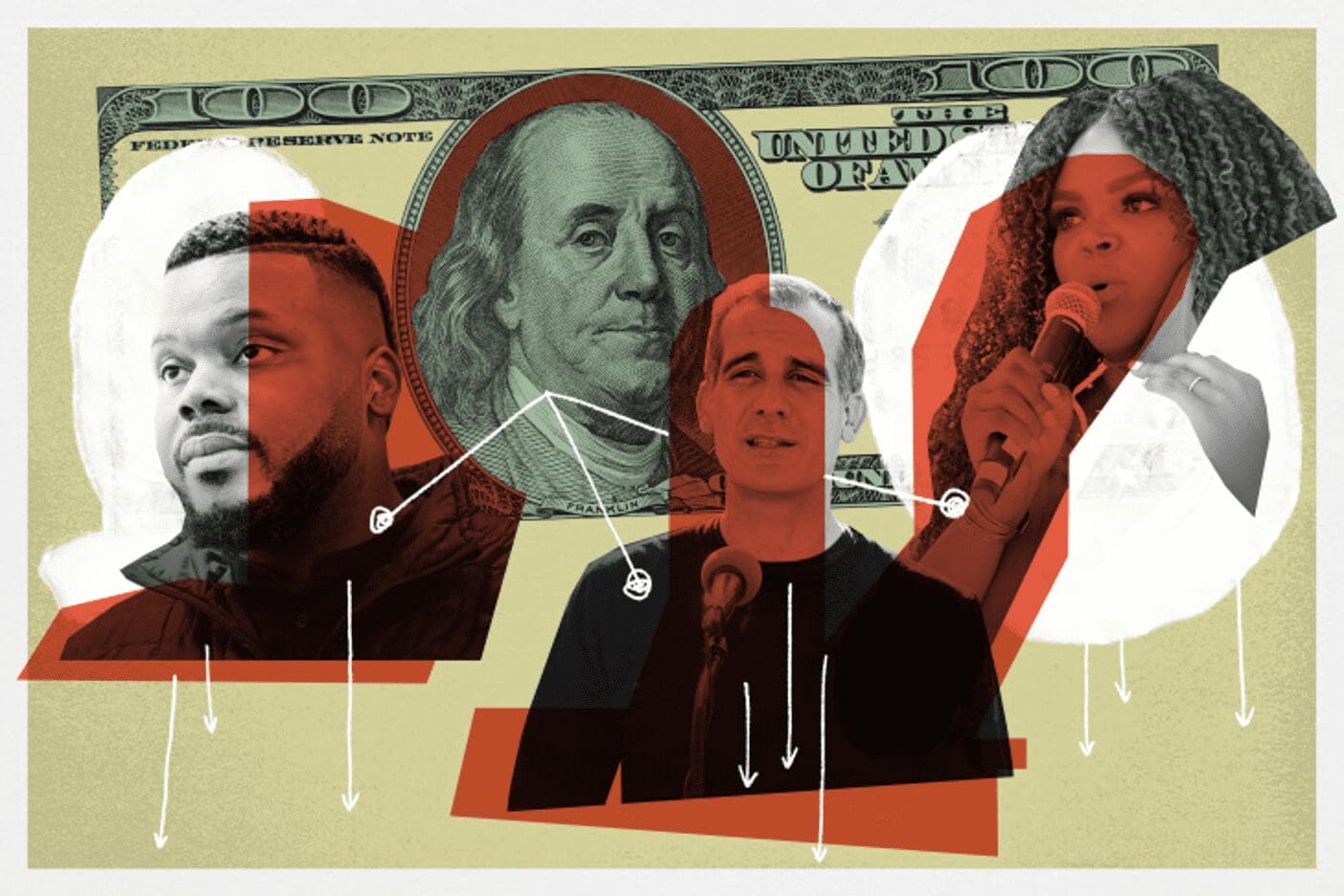The $24 million program in LA would be the largest UBI experiment of its kind in the United States. The stakes couldn’t be higher.
By: LIBBY DENKMANN
Los Angeles Mayor Eric Garcetti is proposing a guaranteed basic income pilot program in his upcoming budget, putting L.A. front and center in the debate over how government can most effectively combat poverty and spur equitable economic recovery in the wake of the coronavirus pandemic.
The $24 million program would be the largest experiment of its kind in the United States.
Under the proposal, dubbed “BIG: LEAP” (Basic Income Guaranteed: L.A. Economic Assistance Pilot), 2,000 Angeleno families at or below the federal poverty line would receive $1,000 a month for one year, no strings attached.
“We have to end America’s addiction to poverty,” Garcetti said in an exclusive interview with LAist. “For families who can’t think past the next bill, the next shift or the next health problem that they have, we can give them the space to not only dream of a better life, but to actualize it.”
The selection criteria for participant households is still being developed, but will likely include supporting a child under the age of 18 and a demonstrated medical or financial hardship connected to COVID-19, the Mayor’s office said. Each council district would have a share of funding based on its poverty rate. The program would be open to everyone regardless of immigration status.
The goal? If successful, the Los Angeles pilot would serve as a major proof-of-concept for direct cash assistance that is divorced from the work requirements attached to many safety net programs for poor Americans, such as the Earned Income Tax Credit.
The concept of a guaranteed basic income is not new, but it’s gained steam with recent high-profile tests in Finland; Ontario, Canada; Maricá, Brazil; and Stockton, California. The economic fallout from the coronavirus crisis has also cracked open the long-running conversation about financial assistance and poverty alleviation. Last year, Garcetti used his nonprofit, The Mayor’s Fund, to raise money for cash transfers via prepaid debit cards, which were distributed to more than 100,000 city residents. (Demand for these far outstripped supply — over four times that many people applied for the so-called Angeleno Card.)
“This pandemic has thrown everything up in the air,” Garcetti said. “This is an America willing to say, If we were so good, why did so many people die? Why was it so disproportionate in certain communities? And if we’re not as good as we thought we were, how can we become better?“
The ambitious guaranteed income experiment is part of an “Equity and Justice Budget” the Mayor will introduce in his State of the City speech Monday evening, which will also include a sharp increase in spending on housing and homelessness programs. It’s a dramatic shift from the grim math of last spring, when Garcetti laid out his initial plan to survive the looming fiscal calamity of COVID-19: service cuts, worker furloughs and digging deep into the city’s reserve funds. It was a road map cobbled together as public health officials were still coming to terms with the scope of the pandemic, and shortly before George Floyd was killed by a Minneapolis police officer, setting off months of protests and calls to defund law enforcement and reimagine public safety.
Last month, the Biden Administration and congressional Democrats threw local governments a life-preserver in the form of the $1.9 trillion American Rescue Plan. It includes $1.3 billion in aid for the city of L.A.
Garcetti says he plans to use the money to “transform systems,” including funding a new Youth Development Department and upping the city’s investment in unarmed response to mental health crises.
“This is not small ball,” Garcetti said. “It isn’t just the biggest budget I’ve ever overseen — it’s the most progressive, and I would argue the most progressive in the country.”
Another guaranteed income pilot program focused on single parents is already in the works for Council District 9, including large parts of South Los Angeles and downtown Los Angeles. Councilmember Curren Price plans to use $6 million to pay for the experiment, earmarked from funding that was cut from the LAPD budget last summer.
LEARNING FROM STOCKTON
An unconditional monthly check means “acknowledging the dignity of people and giving people some agency over their time,” said former Stockton Mayor Michael Tubbs, who founded the group Mayors for Guaranteed Income and is working with Garcetti on the Los Angeles pilot. He credits the Black Lives Matter movement with propelling the effort.
“Economic insecurity was an issue before COVID-19. Income inequality was an issue before COVID-19,” Tubbs said. “Dr. King called for guaranteed income in 1967. But the pandemic really illustrated the ways the economy isn’t working for many people.”
The two-year Stockton Economic Empowerment Demonstration was funded by private donations and recently ended. Through the program, 125 residents received $500 per month, starting in February, 2019. Researchers with the University of Pennsylvania found the program did not discourage people from working, and it leveled out income volatility, improved health outcomes, and lowered anxiety and depression in participants.
Full-time employment increased for people receiving the $500 a month by 12 percent, compared to five percent in the control group. Participants spent the vast majority of the money on staples such as groceries, utilities, gas and rent — and less than one percent on cigarettes or alcohol.
“People did amazing things with the money,” Stockton’s former mayor said. “Whether it was to pay for childcare, take time off to apply for a full-time job, or pay off credit card debt.”
The Wall Street Journal editorial board recently criticized the University of Pennsylvania analysis as politically biased “hype,” reliant on self-reporting and a too-small sample size. The research team that evaluated the Stockton program, led by Amy Castro Baker and Stacia Martin-West, have signed on as partners in the design of the Los Angeles pilot.
“My words for critics are — we know the status quo isn’t working,” Tubbs said. “And that’s why we’re doing pilots across the country. Data, unfortunately, doesn’t drive enough decision making in our country. See the gun debate, or climate change.”THE COMPTON PLEDGE
L.A.’s big pitch for guaranteed income follows the launch of a program in Compton, called The Compton Pledge, championed by outgoing Mayor Aja Brown.
Starting in January, the program began delivering strings-free cash payments to Compton households below the poverty line.
Last week, the group announced it had reached full enrollment, with 800 households representing 1,770 participants, including families and dependents. They are receiving an average of $300-600 a month for two years, scaled by household size. The effort is being funded by more than $8 million in private donations.
In the Compton model, participants can choose to get the money via Venmo, Paypal, direct bank deposit or a prepaid debit card. They aren’t required to produce a social security or taxpayer I.D. number, making the process available to immigrants without documentation.
The program’s director, Nika Soon-Shiong, says the cohort is representative of Compton as a whole in terms of race, gender, immigration status and whether they were ever incarcerated. She hopes the findings of the study will help inform future policy decisions and answer questions around the most effective timing and size of cash transfers.
“The welfare programs that exist today are insufficient, and too many people fall through the cracks,” Soon-Shiong said. “What we need is a system that looks at the well-being of all residents, and that’s less punitive. We really see this policy as a window of opportunity to enhance the social safety net across the board.”
“Honestly, at first I thought it was a scam,” laughed Roslyn Ford, a Compton Pledge recipient. She’s a mother of three with a 15-year-old son and twin nine-year-old daughters. When the pandemic hit, she struggled with the extra cost of internet at home for distance learning for her kids, on top of her regular bills.
“Everything was adding up — my water bill, my cable bill, electricity. I did not know where my help was coming from,” Ford said. “When I got the first deposit, I ran to the water company — I paid everything. And I had a little extra to spend on my children. I’m really appreciative of that.”
Feedback from participants such as Ford will guide the future of cash transfer programs, according to Soon-Shiong.
“Their voices are really important because they are going to be the policy experts when it comes to how to inform the way that we approach guaranteed income implementation moving forward,” Soon-Shiong said.
THE DEBATE OVER WORK REQUIREMENTS
Cash assistance for working-age, able-bodied adults has been a political sticking point for decades. During the Trump Administration, the federal government and Republican-led states pushed to tie more types of government assistance to work.
Conservative policy makers operate on the theory that cash or medical assistance for able-bodied people discourages them from finding employment that could lead to an escape from poverty. It’s the same argument that motivated the “welfare reform” legislation signed by President Clinton in 1996, which added time limits and work requirements to assistance for needy families. Conservative scholar Scott Winship with the Manhattan Institute argues that the initiative was a success — a combination of restructuring welfare, refundable tax credits and non-cash benefits such as food stamps reduced child poverty considerably between 1996 and 2014.
Liberals dismiss the idea that cash assistance makes people lazy, and say evidence shows the Clinton-era changes exacerbated severe poverty.
“It’s about illustrating that we can trust people — including people who struggle economically, including people of color, including women — to make their own decisions on what to do with money,” Stockton’s Tubbs said. “Poverty isn’t some deficiency in people. What’s lacking, in every case, is cash.”
While Clinton-era welfare reform initially appeared to boost employment, it’s hard to separate those effects from the roaring economy of the 1990s. Research by the University of Kentucky found that any earnings gains for poor women with children were mostly offset by the loss of federal help, and “have left the most vulnerable … either running in place or falling behind.” Analysis from the Center on Budget and Policy Priorities echoed this conclusion and found that employment gains were modest and faded over time. Most people worked even if they were not forced to, and income for the bottom 10 percent of single mothers with kids declined in the decade after welfare reform.
“The dichotomy between welfare and work, I think, is a false dichotomy when you look at the persistence of involuntary unemployment across America, especially in communities such as Compton,” Soon-Shiong said. “It’s a really important time to revisit the assumptions that have been underlying our existing welfare programs.”
There is a long-running example of no-questions-asked payments to consider: In Alaska, every resident gets a yearly cash dividend from oil reserve royalties — maybe the closest thing to a universal basic income that academics can sink their teeth into. A study of the state’s program by University of Chicago researchers found no significant impact on employment.




















